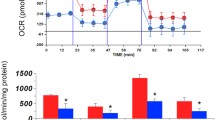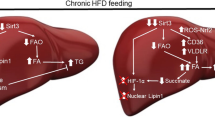Abstract
Glycogen storage disease type Ia (GSD-Ia) deficient in glucose-6-phosphatase-α (G6Pase-α) is a metabolic disorder characterized by impaired glucose homeostasis and a long-term complication of hepatocellular adenoma/carcinoma (HCA/HCC). Mitochondrial dysfunction has been implicated in GSD-Ia but the underlying mechanism and its contribution to HCA/HCC development remain unclear. We have shown that hepatic G6Pase-α deficiency leads to downregulation of sirtuin 1 (SIRT1) signaling that underlies defective hepatic autophagy in GSD-Ia. SIRT1 is a NAD+-dependent deacetylase that can deacetylate and activate peroxisome proliferator-activated receptor-γ coactivator 1α (PGC-1α), a master regulator of mitochondrial integrity, biogenesis, and function. We hypothesized that downregulation of hepatic SIRT1 signaling in G6Pase-α-deficient livers impairs PGC-1α activity, leading to mitochondrial dysfunction. Here we show that the G6Pase-α-deficient livers display defective PGC-1α signaling, reduced numbers of functional mitochondria, and impaired oxidative phosphorylation. Overexpression of hepatic SIRT1 restores PGC-1α activity, normalizes the expression of electron transport chain components, and increases mitochondrial complex IV activity. We have previously shown that restoration of hepatic G6Pase-α expression normalized SIRT1 signaling. We now show that restoration of hepatic G6Pase-α expression also restores PGC-1α activity and mitochondrial function. Finally, we show that HCA/HCC lesions found in G6Pase-α-deficient livers contain marked mitochondrial and oxidative DNA damage. Taken together, our study shows that downregulation of hepatic SIRT1/PGC-1α signaling underlies mitochondrial dysfunction and that oxidative DNA damage incurred by damaged mitochondria may contribute to HCA/HCC development in GSD-Ia.





Similar content being viewed by others
Abbreviations
- GSD-Ia:
-
Glycogen storage disease type Ia
- G6Pase-α:
-
Glucose-6-phosphatase-α
- HCA:
-
Hepatocellular adenoma
- HCC:
-
Hepatocellular carcinoma
- SIRT1:
-
Sirtuin 1
- PGC-1α:
-
Peroxisome proliferator-activated receptor-γ coactivator 1α
- G6P:
-
Glucose-6-phosphate
- OXPHOS:
-
Oxidative phosphorylation
- ETC:
-
Electron transport chain
- GCN5:
-
General control non-repressed protein 5
- WP:
-
Weeks post G6pc gene deletion
- rAAV:
-
Recombinant adeno-associated virus
- MTCO1:
-
Mitochondrially encoded cytochrome c oxidase 1
- MTATP6:
-
Mitochondrial gene encoded subunit 6 of mitochondrial ATP synthase
- TFAM:
-
Mitochondrial transcription factor A
- ACLY:
-
ATP-citrate lyase
- PINK1:
-
PTEN-induced putative kinase 1
- 8-OHdG:
-
8-hydroxy-2′-deoxyguanosine
References
Ashrafi G, Schwarz TL (2013) The pathways of mitophagy for quality control and clearance of mitochondria. Cell Death Differ 20:31–42
Austin S, St-Pierre J (2012) PGC1alpha and mitochondrial metabolism--emerging concepts and relevance in ageing and neurodegenerative disorders. J Cell Sci 125:4963–4971
Cho JH, Kim GY, Pan CJ et al (2017) Downregulation of SIRT1 signaling underlies hepatic autophagy impairment in glycogen storage disease type Ia. PLoS Genet 13:e1006819
Chou JY, Matern D, Mansfield BC, Chen YT (2002) Type I glycogen storage diseases: disorders of the glucose-6-phosphatase complex. Curr Mol Med 2:121–143
Chou JY, Jun HS, Mansfield BC (2010) Glycogen storage disease type I and G6Pase-beta deficiency: etiology and therapy. Nat Rev Endocrinol 6:676–688
Cogliati S, Enriquez JA, Scorrano L (2016) Mitochondrial cristae: where beauty meets functionality. Trends Biochem Sci 41:261–273
DeBerardinis RJ, Lum JJ, Hatzivassiliou G, Thompson CB (2008) The biology of cancer: metabolic reprogramming fuels cell growth and proliferation. Cell Metab 7:11–20
Farah BL, Sinha RA, Wu Y et al (2017) Hepatic mitochondrial dysfunction is a feature of glycogen storage disease type Ia (GSDIa). Sci Rep 7:44408
Fosslien E (2001) Mitochondrial medicine--molecular pathology of defective oxidative phosphorylation. Ann Clin Lab Sci 31:25–67
Gorman GS, Chinnery PF, DiMauro S et al (2016) Mitochondrial diseases. Nat Rev Dis Primers 2:16080
Jeninga EH, Schoonjans K, Auwerx J (2010) Reversible acetylation of PGC-1: connecting energy sensors and effectors to guarantee metabolic flexibility. Oncogene 29:4617–4624
Jones JG, Garcia P, Barosa C, Delgado TC, Diogo L (2009) Hepatic anaplerotic outflow fluxes are redirected from gluconeogenesis to lactate synthesis in patients with type 1a glycogen storage disease. Metab Eng 11:155–162
Mutel E, Abdul-Wahed A, Ramamonjisoa N et al (2011) Targeted deletion of liver glucose-6 phosphatase mimics glycogen storage disease type 1a including development of multiple adenomas. J Hepatol 54:529–537
Palikaras K, Tavernarakis N (2014) Mitochondrial homeostasis: the interplay between mitophagy and mitochondrial biogenesis. Exp Gerontol 56:182–188
Riede UN, Spycher MA, Gitzelmann R (1980) Glycogenosis type I (glucose 6-phosphatase deficiency): I. Ultrastructural morphometric analysis of juvenile liver cells. Pathol Res Pract 167:136–150
Sazanov LA (2015) A giant molecular proton pump: structure and mechanism of respiratory complex I. Nat Rev Mol Cell Biol 16:375–388
Shulman RG, Rothman DL (2017) The glycogen shunt maintains glycolytic homeostasis and the Warburg effect in cancer. Trends Cancer 11:761–767
Sotgia F, Whitaker-Menezes D, Martinez-Outschoorn UE et al (2012) Mitochondrial metabolism in cancer metastasis: visualizing tumor cell mitochondria and the “reverse Warburg effect” in positive lymph node tissue. Cell Cycle 11:1445–1454
Sun Q, Zhong W, Zhang W, Zhou Z (2016) Defect of mitochondrial respiratory chain is a mechanism of ROS overproduction in a rat model of alcoholic liver disease: role of zinc deficiency. Am J Physiol Gastrointest Liver Physiol 310:G205–G214
Ventura-Clapier R, Garnier A, Veksler V (2008) Transcriptional control of mitochondrial biogenesis: the central role of PGC-1alpha. Cardiovasc Res 79:208–217
Vyas S, Zaganjor E, Haigis MC (2016) Mitochondria and cancer. Cell 66:555–566
Wei Y, Rector RS, Thyfault JP, Ibdah JA (2008) Nonalcoholic fatty liver disease and mitochondrial dysfunction. World J Gastroenterol 14:193–199
Wellen KE, Hatzivassiliou G, Sachdeva UM, Bui TV, Cross JR, Thompson CB (2009) ATP-citrate lyase links cellular metabolism to histone acetylation. Science 324:1076–1080
Yiu WH, Lee YM, Peng WT et al (2010) Complete normalization of hepatic G6PC deficiency in murine glycogen storage disease type Ia using gene therapy. Mol Ther 18:1076–1084
Zong WX, Rabinowitz JD, White E (2016) Mitochondria and cancer. Mol Cell 61:667–676
Acknowledgements
We thank Dr. Pierre Chambon for the gift of the AlbCreERT2 mice. Microscopy imaging was performed at the Microscopy & Imaging Core (National Institute of Child Health and Human Development, NIH) with the assistance of Chip Dye.
Funding
This work was supported by the Intramural Research Program of the Eunice Kennedy Shriver National Institute of Child Health and Human Development, National Institutes of Health; and by the Children’s Fund for Glycogen Storage Disease Research.
Author information
Authors and Affiliations
Corresponding author
Ethics declarations
Conflict of interest
J.-H. Cho, G.-Y. Kim, B. C. Mansfield, and J. Y. Chou declare that they have no conflict of interest.
Animal rights
All institutional and national guidelines for the care and use of laboratory animals were followed.
Additional information
Communicated by: Terry G.J. Derks
Rights and permissions
About this article
Cite this article
Cho, JH., Kim, GY., Mansfield, B.C. et al. Sirtuin signaling controls mitochondrial function in glycogen storage disease type Ia. J Inherit Metab Dis 41, 997–1006 (2018). https://doi.org/10.1007/s10545-018-0192-1
Received:
Revised:
Accepted:
Published:
Issue Date:
DOI: https://doi.org/10.1007/s10545-018-0192-1




